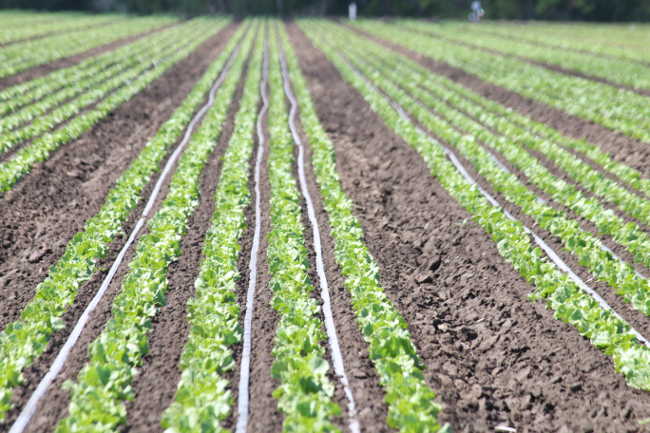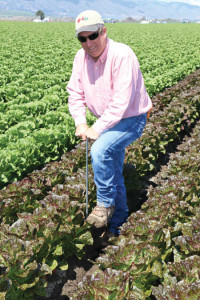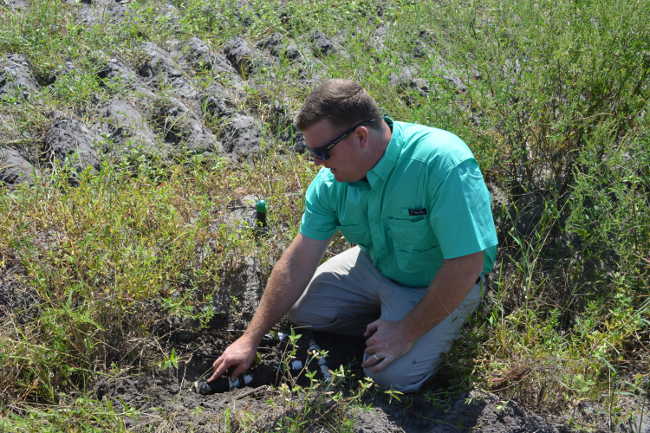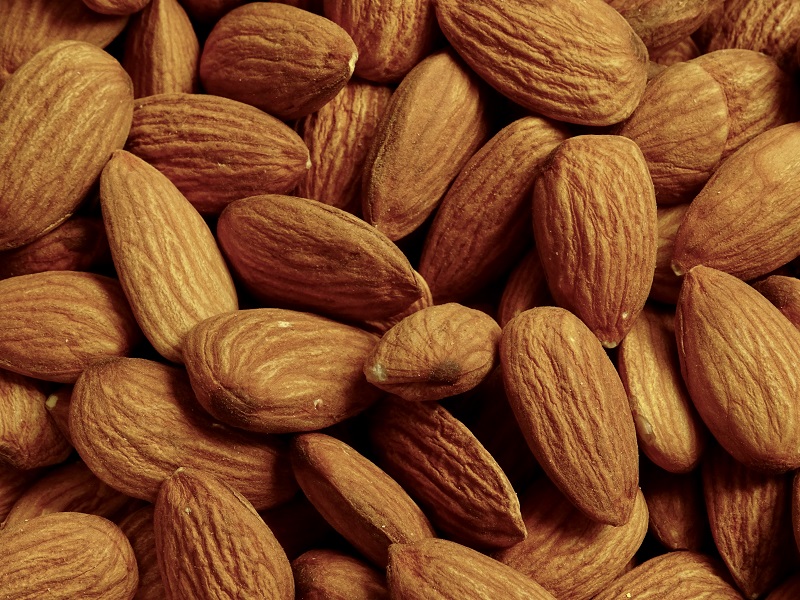Growing More With Less Water
It’s no secret that water has been under the proverbial spotlight as of late. How much of it is there? Who’s controlling it? There’s a lot of pressure for answers, and even more for solutions as resources continue to wane out West.
With drought conditions worsening in California, in early April, Governor Jerry Brown imposed mandatory water restrictions on citizens for the first time, requiring cities to reduce their consumption by 25%.
The mandate for agriculture came in less narrowly defined, and under the new rule growers will now be required to report more water-use information to state regulators.

Photo credit: Michael Cahn
To survive, most California growers have already stepped up to the conservation challenge and have adopted techniques to manage water more efficiently.
Florida’s growers, on the other hand, are not hurting for water, but have to manage a different set of water-related regulations.
Although California and Florida represent two extremes in terms of water availability, two growers in either state have shown that responsible use of this commodity is not only kind to the environment, but it can also improve your bottom line.
New Web-Based Irrigation And Nitrogen System
At Huntington Farms in Soledad, CA, Certified Crop Advisor and Pest Control Advisor Mark Mason has adopted the use of a free web-based irrigation system called CropManage. The system closely monitors water and nitrate usage, and has enabled the operation to significantly reduce both. Drought conditions at Huntington Farms — which produces 7,000 acres of lettuce, broccoli, cauliflower, celery, and strawberries — aren’t quite as pronounced as in other areas of the state thanks to the availability of quality groundwater, which the farm pumps from its nearby wells.

Mark Mason, PCA, CCA, Huntington Farms, Soledad, CA
However, as the threat of groundwater depletion looms, Mason has taken a proactive stance to conserve water with the help of CropManage. The software, which helps growers determine water and nitrogen fertilizer applications on a field-by-field basis, was developed by Michael Cahn, Irrigation and Water Resources Farm Advisor at University of California’s Cooperative Extension (UCCE), Monterey County. The software is available for download at https://ucanr.edu/cropmanage.
Using weather data from the California Irrigation Management Information System, the software automatically designs steps required to calculate crop water needs. It also estimates nitrogen needs for lettuce using test data and models of crops’ nitrogen uptake.
The system works by integrating data the user provides on specific plantings with information on location, soil type, plant date, expected harvest date, acreage, crop type, the irrigation system used, soil nitrogen, and previous crop residues. That information is then used to calculate irrigation and fertilizer application needs, which the user can adapt as needed.
“There are specific parameters you need to set up, so if you’ve put in ‘irrigated with sprinklers,’ that’s not enough. You need to know the row spacing of your pipe, nozzle size, your front and back pressure, etc.,” Mason explains.
Currently, the software is available for a select number of crops including Romaine lettuce, iceberg lettuce, broccoli, cauliflower, cabbage, and strawberries. Other crops currently being modeled for the system include spinach, celery, onion, and pepper. Furthermore, UC advisors in the Central Valley are working on adopting CropManage for processing tomatoes, alfalfa, and almonds.
Promising Results
After trialing CropManage on 200 acres of head lettuce fields that were contracted to Fresh Express in 2014, Mason saw a significant decrease in water use, and a significant decrease in fertilizer use with comparable yields to fields not being trialed under the CropManage system.

Huntington Farms’ Management, includes: Nick Huntington, president; Chris Huntington, CEO; Manuel Paz, Farm Manager; Mark Mason, PCA, CCA“
“With some of these high-value crops we’ve got $3,500-$4,000 an acre invested, so we have to irrigate that whole field to our weakest point to make that one spot be just as good as everything else,” Mason says. “So when they do those efficiency tests, they find that weak spot and we fix it. That way you don’t overwater the rest of your field.”
A Mobile Component
Because CropManage is a web-based system that requires data input from a laptop or desktop computer off-field, Mason decided to develop a mobile component to accompany CropManage. With the new app called Farm Manage, his irrigators can enter in crop information while they’re in the field, which later syncs to CropManage.
The app is currently in the final stages of development. “Instead of writing irrigation and fertilizer data in a book, our ranch manager Manual Paz has given his guys tablets. It’s neater, it’s more organized, and it can go in a database that we feed into CropMange,” he explains.
Mason has planned for Farm Manage to take well water into account, integrating nitrogen fluctuation levels into the software throughout the year. It will also feed irrigation water volume data into the fertilizer program, allowing CropManage to provide irrigation and fertilizer recommendations based on those levels.
Mason says he hopes to include more than just crop data in the app, and at the moment has plans to include seed, pesticide, and fertilizer inventory.
Click on the next page to continue reading…
A New Way Of Irrigating In Florida
Responding to state-mandated Best Management Practices (BMPs) enacted in 1999, which seek to address water quality and conservation concerns, Bryan Jones at Riverdale Potato Farm in St. Augustine, FL has blazed the trail for growers in his area with his enhanced seepage irrigation technique.
Jones has been using the enhanced seepage irrigation technique since 2010, and has helped install it on seven other farms in the area since then. The system has drastically reduced his water usage and eliminated runoff from his 1,100-acre operation into the nearby St. John’s River.

Bryan Jones of Riverdale Potato Farms, St. Augustine, FL. Photo(s) credit: Frank Giles
“We don’t have miles and miles of swamp land to filter anything out so we have to do the best that we can, and that’s what we do. The fact that zero water leaves our operation is exceptional,” he says.
How It Works
Jones’ enhanced drip irrigation system uses drip tape which he buys from Rivulus Irrigation, but unlike traditional drip systems where the tape may only be buried a few inches down or laid flat on the ground, Jones’ drip tape is buried 14 inches below the alley.
With the tape being buried so deep, none of the equipment hits it, Jones explains. “I want our tape to be here 20 years from now. It’s deep enough so that none of my tractors are running over it; it’s going to be there.”

Burying drip tape 14 inches below the alley has helped Riverdale Potato Farms reduce water use
and eliminate runoff from their operation.
According to Jones, in North Florida there is a six- to eight-week irrigation season from February to April where growers irrigate 24 hours a day, seven days a week. With the enhanced seepage irrigation system, Jones can turn his irrigation on and off as needed.
“Once I bring that water table up I can run the system for eight hours a week and shut it off,” he says.
“There’s no transpiration because everything is underground — all of the water stays right where it needs to be, which gives the roots the ability to reach out and grab nutrients that were just sitting there before. We’re able to maximize what we’re putting out; the plants absorb it, and that’s what we want.”
The end result, he says, is a healthier, stronger plant with a better yield.
In a trial where Jones planted two identical 30-acre blocks side by side — one using conventional flood irrigation techniques, and other using the enhanced seepage technology — Jones saw $10,000 more profit in the acreage using enhanced seepage.
“The second those plants start to stress you have yield loss. I don’t want to stress that plant. I want it to stay right in that happy medium through controlled irrigation, and that’s what I’m able to do with this system,” he says.
Fertilizer Reduction
When Jones adopted the enhanced seepage irrigation system he was also able to upgrade his fertilizer equipment to a fertilizer bander through funds made available from the Florida Department of Agriculture and Consumer Services, the St. John’s River Water Management District, and the USDA Natural Resources Conservation Center.
Before, Jones was spreading his fertilizer. The new banding equipment allows for a more precise application of nutrients, dropping the fertilizer 10 inches above the row. With this new system, Jones says he’s reduced his fertilizer use by 25%.
“The system focuses [the fertilizer] directly onto the plant, so everything stays right where we want it to be — in the root zone. It’s not going into the water furrows and running out, and it’s not in the turn rows. There’s zero waste. With that being said, you can lower your rates because you don’t need as much,” he explains.
Growers interested in seeking funds for the banding equipment and other water-management projects should visit SJRWMD.com for more details.
An Optimistic Outlook
Both Jones and Mason have big hopes for the future and hope to stay on track with current conservation practices.
“We’re going to be way more efficient than where we are right now with water and fertilizer — those two go hand in hand. This will happen through technology and educating people that work on the ranch,” Mason says.
Similar to Mason, Jones’ mantra is to do more with less.
“We’re always looking to update. We’re looking for the next thing to better our yield, and better the quality without using more. We want to grow more and water less.”









